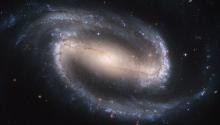Listen to today's episode of StarDate on the web the same day it airs in high-quality streaming audio without any extra ads or announcements. Choose a $8 one-month pass, or listen every day for a year for just $30.
You are here
Eridanus Cluster
If you look south two or three hours after sunset tonight, you’ll be gazing into one of the largest of all the 88 constellations — Eridanus, the river. It’s long and winding, and not easy to see. It hosts one of the brightest stars in the sky, but the star is so far south that it’s out of sight for most Americans.
Eridanus also is home to a cluster of galaxies. The galaxies spread over a range of distances, but the center of the cluster is probably about 75 million light-years from Earth.
The cluster is a grander gathering than the Local Group, the collection of galaxies that includes our home galaxy, the Milky Way. For one thing, the Eridanus cluster has more galaxies. For another, its largest galaxies have more diversity: some are elliptical galaxies and some are spirals. In contrast, the only two giants in the Local Group are both spirals.
One of the most impressive members of the Eridanus cluster is NGC 1300. It’s a breath-taking barred spiral that looks like a backward letter S. It has two enormous spiral arms that are spawning new stars. The spiral arms emerge from opposite ends of a long bar, which houses mainly older stars. The Milky Way is also a barred spiral, but its bar is much less prominent.
Next door to the Eridanus cluster is the better-known Fornax cluster, which is slightly closer to us. Both clusters are part of a long filament of galaxies, which stretches across the southern sky tonight.
Script by Ken Croswell





